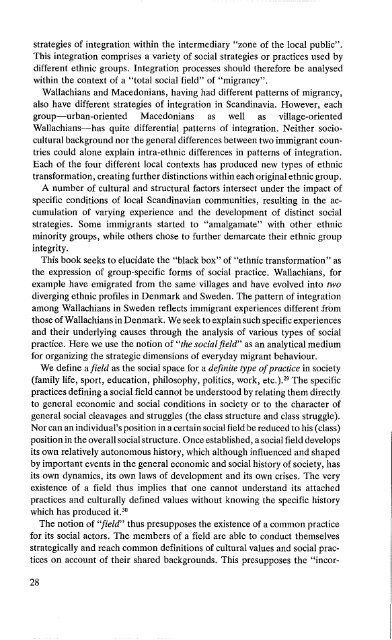Will they still be dancing? (1982)
Etnographic study of Romanians from East Serbia in Sweden in 1980s
Etnographic study of Romanians from East Serbia in Sweden in 1980s
Create successful ePaper yourself
Turn your PDF publications into a flip-book with our unique Google optimized e-Paper software.
strategies of integration within the intermediary "zone of the local public".<br />
This integration comprises a variety of social strategies or practices used by<br />
different ethnic groups. Integration processes should therefore <strong>be</strong> analysed<br />
within the context of a "total social field" of "migrancy".<br />
Wallachians and Macedonians, having had different patterns of migrancy,<br />
also have different strategies of integration in Scandinavia. However, each<br />
group-urban-oriented Macedonians as well as village-oriented<br />
Wallachians-has quite differential patterns of integration. Neither sociocultural<br />
background nor the general differences <strong>be</strong>tween two immigrant countries<br />
could alone explain intra-ethnic differences in patterns of integration.<br />
Each of the four different local contexts has produced new types of ethnic<br />
transformation, creating further distinctions within each original ethnic group.<br />
A num<strong>be</strong>r of cultural and structural factors intersect under the impact of<br />
specific conditions of local Scandinavian communities, resulting in the accumulation<br />
of varying experience and the development of distinct social<br />
strategies. Some immigrants started to "amalgamate" with other ethnic<br />
minority groups, while others chose to further demarcate their ethnic group<br />
integrity.<br />
This book seeks to elucidate the "black box" of "ethnic transformation" as<br />
the expression of group-specific forms of social practice. Wallachians, for<br />
example have emigrated from the same villages and have evolved into two<br />
diverging ethnic profiles in Denmark and Sweden. The pattern of integration<br />
among Wallachians in Sweden reflects immigrant experiences different Jrom<br />
those ofWallachians in Denmark. We seek to explain such specific experiences<br />
and their underlying causes through the analysis of various types of social<br />
practice. Here we use the notion of "the social field" as an analytical medium<br />
for organizing the strategic dimensions of everyday migrant <strong>be</strong>haviour.<br />
We define a field as the social space for a definite type ofpractice in society<br />
(family life, sport, education, philosophy, politics, work, etc.)." The specific<br />
practices defining a social field cannot <strong>be</strong> understood by relating them directly<br />
to general economic and social conditions in society or to the character of<br />
general social cleavages and struggles (the class structure and class struggle).<br />
Nor can an individual's position in a certain social field <strong>be</strong> reduced to his (class)<br />
position in theoverall social structure. Onceestablished, a social field develops<br />
its own relatively autonomous history, which although influenced and shaped<br />
by important events in the general economic and social history of society, has<br />
its own dynamics, its own laws of development and its own crises. The very<br />
existence of a field thus implies that one cannot understand its attached<br />
practices and culturally defined values without knowing the specific history<br />
which has produced it. 30<br />
The notion of "field" thus presupposes the existence of a common practice<br />
for its social actors. The mem<strong>be</strong>rs of a field are able to conduct themselves<br />
strategically and reach common definitions of cultural values and social practices<br />
on account of their shared backgrounds. This presupposes the "incor-<br />
28
















